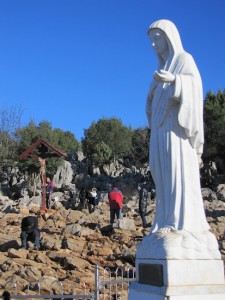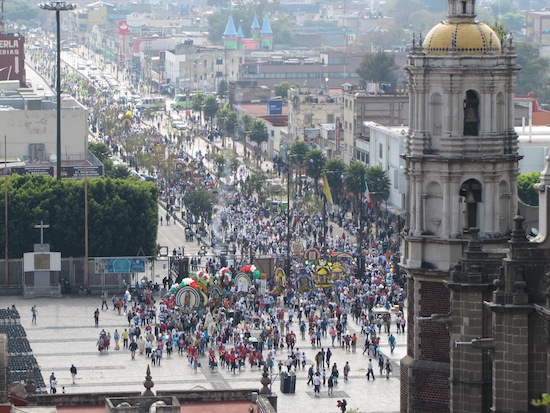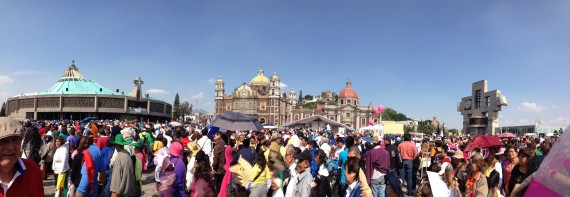
Alumni Memorial Scholar Kelsey Bash ’15 at the Basilica of the Immaculate Conception in Lourdes, France.
Alumni Memorial Scholar Kelsey Bash ’15, a Molecular Biology major, used her AMS Grant to travel the world during the winter of 2014-15. Her project, titled “The Transculturation of Marian Apparitions,” examined how the appearance of the Virgin Mary was expressed in Catholic communities around the globe. As a practicing Catholic herself, Kelsey found rich meaning on both a personal and intellectual level throughout her study. What follows are photographs and a written report describing her experience at each site.
During the Christmas season of miracles, I was able to go on a miraculous around-the-world journey using an AMS Grant. The goal of my project was to consider the transculturation of the Catholic Church through the lens of Marian apparitions, and it was also a pilgrimage of great self-discovery. I was blessed to visit five countries and six Marian sites over the course of three weeks and will reflect on each separately before making some general conclusions.
Firstly, some background information may be helpful. A Marian apparition is defined by the appearance of the Virgin Mary to a particular person or persons. There have been thousands of reported apparitions of Mary in the 2,000 years since her assumption, with more apparitions reported in the 20th century than in any other. While there is some controversy among believers and in the Church, with only 9 apparitions receiving official Vatican approval, the fruits of the apparitions are evident. Countless miracles, healings, and conversions have resulted from Mary’s appearances.

Convent where a wooden statue of Mary spoke and wept 101 times in the 70s.
My trip started in Akita, Japan, at the Convent Seitai Hoshikai where Mary appeared to a Sister Agnes Sasagawa in 1973. Sr. Agnes, previously deaf, heard a “voice of indescribable beauty” coming from a wooden statue of the Virgin Mary and received three messages from the Virgin. The statue then wept 101 times from 1975 to 1981, with over 500 witnesses. I was blessed to spend time alone (January being an unpopular time for pilgrimage) with the miraculous statue in the convent chapel. Kneeling before Mary two feet away, I could feel the warmth of her graces, but also the urgency in her call to pray for the conversion of sinners as relayed by Sr. Agnes.
Next, I embarked for Medjugorje, Bosnia-Herzegovina, one of the most visited and most controversial apparition sites, with Mary still reportedly appearing to some of the visionaries today. In 1981, Mary appeared to 6 Bosnian children with a call to conversion and prayer and with 10 secrets regarding the end of the world. Mary told the visionaries that she would continue to appear to them daily until revealing the 10th secret and presently two visionaries continue to receive daily apparitions while the others receive monthly or yearly messages, many of which are made public online.

Statue of Our Lady, Queen of Peace on Apparition Hill.
I arrived in Medjugorje on the eve of the Feast of Mary, Mother of God on January 1st, just in time to join the hoards of devout pilgrims for a midnight vigil. I stood outside for the vigil, watching the Croatian mass on a large screen and occasionally being able to peak in through the crowded doorway (despite having arrived two hours early). Each subsequent service I attended–indeed, there were masses and services in many languages throughout the entire day–was similarly packed. Entering into such an international and devout Body of Christ was an absolute blessing. Medjugorje also offered many intimate encounters with Mary as I prayed my way up the steep and snowy Cross Mountain and up the holy Apparition Hill. I also encountered the commercialism of religious pilgrimage sites in Medjugorje as I walked by (and into, admittedly) tens of shops selling rosaries, prayer cards, medals, and the like.
Mary led me to Paris next, to the chapel at Rue du Bac. Mary appeared in this chapel at the convent of the Sisters of Charity in 1830 to a new novice, Catherine Laboure. Since her mom died during Catherine’s childhood, Catherine had always had a special devotion to Mary and wished nothing more than to see her. This was realized when she was led to the chapel by a young boy, presumably her Guardian Angel, who told her “Come to the chapel; the Blessed Virgin is waiting for you.”
In the chapel, Catherine heard the rustle of a silk dress and saw a beautiful lady sit down in the Priest’s chair. Mary comforted Catherine and told her of things that would come to pass in France in the next 40 years. She also charged Catherine with a mission—one that she explained to Catherine during a second apparition on November 27th. Catherine was to oversee the production of a medal emulating Mary as she appeared to Catherine and with a beautiful symbol on the back. The medal was cast in 1831 and millions distributed within a few years. It quickly became known as the “Miraculous Medal” due to the many conversions and cures it led to. Catherine’s identity as the visionary was not revealed until just before her death in 1876. Catherine was canonized in 1947 and her body was found to be incorrupt. It lies today in the chapel where I was blessed to pray before it.
Indeed, it was miraculous that Mary led me to the chapel just before it closed for two weeks the next day. The chapel at Rue du Bac had an air of Grace unlike anywhere I have ever been. Kneeling before the chair where Mary sat with St. Catherine’s incorrupt body to my right, glancing up at the beautiful statue of Mary, I could feel Mary’s graces pouring down upon me. I was struck by the glorious way the rays pouring out of Mary’s hands pointed directly to Our Lord in the tabernacle situated beneath the statue, confirming Mary’s promise to lead us to Christ.

Chapel at Rue du Bac, Paris, where Mary appeared to St. Catherina Laboure with the image of the Miraculous Medal.
After a quick stop in Paris, I headed to the Pyrenes foothills to Lourdes, France. Mary appeared in 1858 to a 14-year old peasant, Bernadette, in a grotto when she was fetching water. Mary appeared as a young girl of 16 or 17 dressed in a white robe with a blue ribbon at the waist and a white veil on her head. She was carrying rosary beads. Mary appeared to Bernadette 18 times that year with messages of hope and of a need for penitence. Mary caused a miraculous spring to come up from the dry ground that still flows today. At this Grotto, Mary told Bernadette “Que soy era Immaculada Counception,” I am the Immaculate Conception, confirming the Catholic teaching of Mary as Immaculate. Thousands of miracles have been approved in Lourdes, France, and it is once of the largest Catholic pilgrimmage sites for healing.
I was blessed to have a couple of quiet days at Lourdes during the off-season for pilgrimages. I participated in French and English mass in the various chapels and the rosary basilica, bathed in the baths at Lourdes, went to confession, visited the childhood home of Bernadette, and explored all that the beautiful basilica had to offer. My time is Lourdes was a time of penitence and beauty.
I ended my journey at the Basilica of Our Lady of Guadalupe in Mexico City. It was a huge coming home for me, as I have always had a special devotion to Our Lady of Guadalupe and being in North America revering the Patroness of the Americas in a language I spoke was a huge blessing. Guadalupe certainly was not an afterthought as it is the most well known apparition and the most visited Marian shrine in the world with 10 million pilgrims visiting it each year. I spent four days in Mexico City and went to the Basilica each day. The Basilica was built on the site where Mary appeared to a poor farmer, Juan Diego, in 1531. The young Aztec woman asked Juan to have a basilica built on Tepeyac Hill where she greeted him. The Bishop did not believe Juan Diego and asked for a sign. Mary told Juan to pick Castilian roses on the hill—Spanish flowers growing in Mexico, in December. Juan brought the roses to the Bishop and when he unrolled his garment, his “Tilma,” carrying them, the roses fell to the ground and a miraculous image of Mary was on the Tilma. The Bishop fell in veneration and had a basilica built. People quickly came to revere Our Lady, and within 7 years, 8 million Aztecs had converted—the apparition is largely responsible for the Christianization of Latin America. The image of Our Lady remains on the Tilma today, completely unchanged, after nearly 500 years on a fabric that disintegrates after 20 years. Again, thousands of miracles have been attributed to Our Lady of Guadalupe. The basilica remains a very popular pilgrimage site today.

One of many processions to the Basilica with pilgrim groups carrying large floats of Our Lady of Guadalupe.
I was able to partake in many pilgrim activities, attending many masses, walking up and down the Tepeyac and enjoying the bustling commercialism. The number of pilgrims at the Basilica was unparalleled, with groups coming hourly for mass—held from 6am till 6pm with hundreds of pilgrims in each. By happenstance, I was visiting on the day of the annual pilgrimage and enjoyed mass in the square with thousands of Mexicans who had gathered from all of the parishes in Mexico City with the Archbishop and Cardinal. Mexico City felt like home, and Mary was my dear mother fully embracing me.

Annual Pilgrimage Mass with the Archbishop, thousands of pilgrims in the square between the new and old basilicas for mass.
As an added bonus to my trip, I discovered one more apparition site near Mexico City on the final day of my trip. Tlaxcala, Mexico is a city a couple of hours by bus from Mexico City. Mary appeared there in 1541 to Juan Bernardino and brought forth a healing spring of water to cure the villagers from the plague. She also told him to tell the Franciscan monks that she would provide a statue of herself for them. One night in the forest, flames lit all the trees on fire, but the trees did not burn and one in particular stood out. The Franciscans marked it, returned the next day, split it open, and found a statue of the Virgin Mary inside. The statue sits today in the Church of Our Lady of Ocotlán, where I was blessed to spend a day.

Miraculous wooden Statue of Our Lady of Ocotlán that was found inside a tree after a lightening storm.
Mary is known by many different titles, and I encountered her in Our Lady of Akita, Our Lady of the Miraculous Medal, Our Lady of Lourdes, Our Lady of Guadalupe, and Our Lady of Tlaxcala. Most Catholics have a devotion to one particular image of Mary largely depending on the image they’ve encountered most. However, in all of the images, we are worshiping the same woman, the Mother of God. And, indeed, there is a large intertwining of Marian images across cultures. The patroness of the Americas, and absolutely fundamental in Latin American Catholicism, Our Lady of Guadalupe earned a spot in nearly all of the churches in Mexico. Additionally, though, the image of Our Lady of Guadalupe was frequently in other countries as well. Indeed, there was a large icon of Our Lady of Guadalupe at a side chapel in Notre Dame Cathedral in Paris and an image of Our Lady of Guadalupe and Juan Diego at a central altar right next to the basilica in Lourdes. Conversely, the grotto at Lourdes was replicated in many churches in Mexico. I also noticed many consistencies in the images of Mary. Mary’s hands were always formed in prayer, she was frequently carrying a rosary, the sun and the moon were featured largely in the images, and all of the images were consistent with Scripture. From all of this, I received the sense that one can pick whichever image of Mary most resonates with them to revere, but that one MUST pick one. The tradition of the Church, the role of Mary as the Co-Redemptress and Mediatrix of Grace, the writings of the Popes, and in Mary’s messages themselves, emphasize that utmost importance that we honor Mary.
Many people question why Mary appears when she does and how she picks to whom to appear; I found myself asking similar questions of Mary, and also of myself, during my pilgrimage. Why had I been blessed with such an opportunity to discover Mary? Indeed, it seemed nothing short of a miracle to have received an AMS research grant to explore Marian apparitions. I am over-joyed to share the answer I received. While Mary manifests herself differently in each culture, just like Christ who she constantly points her children to, Mary is for ALL, including me!



Kelsey has provided a beautiful account of faith: an affirmation and an adventure. I thank her for all she brings to our school, including this essay.